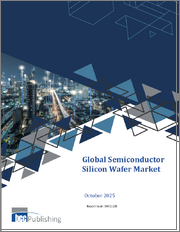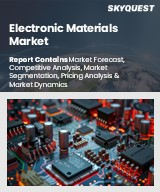
|
시장보고서
상품코드
1577682
세계의 단결정 실리콘 웨이퍼 시장 : 유형별, 최종 이용 산업별 예측(2025-2030년)Monocrystalline Silicon Wafer Market by Type (N-Type, P-Type), End-Use Industry (Automotive, Electronics, Renewable Energy) - Global Forecast 2025-2030 |
||||||
단결정 실리콘 웨이퍼 시장은 2023년에 113억 8,000만 달러로 평가되었고, 2024년에는 119억 4,000만 달러에 도달할 것으로 예측되며, 복합 연간 성장률(CAGR) 5.85%로 성장하여 2030년에는 169억 5,000만 달러에 달할 것으로 예상됩니다.
단결정 실리콘 웨이퍼는 단결정 구조로 태양전지, 마이크로 일렉트로닉스, 각종 전자 용도의 반도체 기판으로 널리 사용되고 있습니다. 그 필요성은 높은 효율과 다결정 실리콘보다 뛰어난 전기 전도 능력으로 인해 일렉트로닉스와 태양에너지 산업에서 필수적입니다. 신재생에너지 솔루션에 대한 수요 증가와 진화하는 첨단기술 산업이 특히 스마트폰, 태블릿, 솔라 패널에의 웨이퍼의 응용을 뒷받침하고 있습니다. 최종 용도의 범위는 주택, 상업, 산업 부문으로, 지속 가능한 에너지 솔루션으로의 전환으로 태양에너지 부문은 최대 소비자 중 하나가 되었습니다. 시장 성장의 원동력이 되고 있는 것은 전자기기 수요 증가, 솔라 패널 기술의 진보, 재생 가능 에너지를 추진하는 정부의 우대 조치 등의 요인입니다. 또한 지속적인 기술 발전으로 제조 비용이 절감되고 제조업체에게 매력적입니다. 그러나 초기 생산 비용의 높이, 제조의 기술적 복잡성, 특정 지역 시장 포화와 같은 문제는 성장을 제한 할 수 있습니다. 웨이퍼 제조에 관한 표준화 문제나 환경 문제도 큰 과제가 되고 있습니다. 주요 비즈니스 기회는 보다 비용 효율적이고 환경 친화적인 생산 방법의 개척과 신흥국 시장의 개척에 있습니다. 웨이퍼 효율을 높이고 제조시 탄소 발자국을 줄이기 위해 R&D 투자를 권장합니다.혁신적인 분야로는 접을 수 있는 전자기기나 효율 향상형 태양광 패널 등의 신기술에 대응하는 플렉서블 단결정 실리콘 웨이퍼의 개발을 들 수 있습니다. 시장 경쟁은 치열하고, 주요 기업은 생산 능력 확대와 전략적 제휴에 주력하여 그 지위를 강화하고 있습니다. 웨이퍼 생산에 있어서 스마트한 제조 수법이나 순환형 경제 원칙의 채용 등 주요 동향의 채용은 사업의 성장으로 이어질 가능성이 있습니다. 이러한 새로운 기술과 관행을 도입함으로써 기업은 현재 시장의 한계를 해결하면서 새로운 기회를 활용할 수 있습니다.
| 주요 시장 통계 | |
|---|---|
| 기준년(2023) | 113억 8,000만 달러 |
| 예측년(2024) | 119억 4,000만 달러 |
| 예측년(2030) | 169억 5,000만 달러 |
| 복합 연간 성장률(CAGR)(%) | 5.85% |
시장 역학: 빠르게 진화하는 단결정 실리콘 웨이퍼 시장의 주요 시장 인사이트 공개
단결정 실리콘 웨이퍼 시장은 수요 및 공급의 역동적 인 상호 작용에 의해 변모하고 있습니다. 이러한 시장 역학의 진화를 이해함으로써 기업은 충분한 정보를 바탕으로 투자결정, 전략적 결정 정밀화, 새로운 비즈니스 기회 획득에 대비할 수 있습니다. 이러한 동향을 종합적으로 파악함으로써 기업은 정치적, 지리적, 기술적, 사회적, 경제적 영역에 걸친 다양한 리스크를 경감할 수 있을 뿐만 아니라 소비자 행동과 그것이 제조 비용 또는 구매 동향에 미치는 영향을보다 명확하게 이해할 수 있습니다.
- 시장 성장 촉진요인
- 단결정 실리콘 웨이퍼의 성능과 효율을 높이는 태양광 발전 기술의 진보
- 주요국에 의한 재생 가능 에너지원의 중시에 의해 단결정 실리콘 웨이퍼의 사용이 증가
- 전기자동차 시장의 급성장에 의해 에너지 저장 솔루션에 있어서의 단결정 실리콘 웨이퍼의 요구가 높아진다
- 스마트 그리드와 IoT 디바이스의 출현에 의한 고품질 단결정 실리콘 웨이퍼 수요 증가
- 시장 성장 억제요인
- 단결정 실리콘 웨이퍼에 경쟁을 가져오는 대체 재료의 기술 진보
- 시장 기회
- 지속가능한 에너지 솔루션을 요구하는 신재생에너지 분야 수요 증가
- 비용 절감과 효율 향상으로 이어지는 제조 공정 개선
- 고성능 가전이나 컴퓨팅 디바이스에의 단결정 실리콘 웨이퍼의 채용
- 시장의 과제
- 단결정 실리콘 웨이퍼 생산과 관련된 환경 규제 및 컴플라이언스 문제
Porter's Five Forces: 단결정 실리콘 웨이퍼 시장을 탐색하는 전략 도구
Porter's Five Forces 프레임 워크는 단결정 실리콘 웨이퍼 시장 경쟁 구도를 이해하는 중요한 도구입니다. Porter's Five Forces Framework는 기업의 경쟁력을 평가하고 전략적 기회를 탐구하는 명확한 기술을 제공합니다. 이 프레임워크는 기업이 시장 내 세력도를 평가하고 신규 사업의 수익성을 판단하는 데 도움이 됩니다. 이러한 통찰을 통해 기업은 자사의 강점을 활용하고, 약점을 해결하고, 잠재적인 과제를 피할 수 있으며, 보다 강인한 시장에서의 포지셔닝을 보장할 수 있습니다.
PESTLE 분석 : 단결정 실리콘 웨이퍼 시장에서 외부로부터의 영향 파악
외부 거시적 환경 요인은 단결정 실리콘 웨이퍼 시장의 성과 역학을 형성하는데 매우 중요한 역할을 합니다. 정치적, 경제적, 사회적, 기술적, 법적, 환경적 요인 분석은 이러한 영향을 탐색하는 데 필요한 정보를 제공합니다. PESTLE 요인을 조사함으로써 기업은 잠재적인 위험과 기회를 더 잘 이해할 수 있습니다. 이 분석을 통해 기업은 규제, 소비자 선호, 경제 동향의 변화를 예측하고 앞으로 예상되는 적극적인 의사 결정을 할 준비를 할 수 있습니다.
시장 점유율 분석 단결정 실리콘 웨이퍼 시장 경쟁 구도 파악
단결정 실리콘 웨이퍼 시장의 상세한 시장 점유율 분석을 통해 공급업체의 성과를 종합적으로 평가할 수 있습니다. 기업은 수익, 고객 기반, 성장률 등 주요 지표를 비교하여 경쟁 포지셔닝을 밝힐 수 있습니다. 이 분석을 통해 시장 집중, 단편화, 통합 동향을 밝혀내고 공급업체는 경쟁이 치열해지면서 자신의 입지를 높이는 전략적 의사 결정을 내리는 데 필요한 지식을 얻을 수 있습니다.
FPNV 포지셔닝 매트릭스 단결정 실리콘 웨이퍼 시장에서 공급업체의 성능 평가
FPNV 포지셔닝 매트릭스는 단결정 실리콘 웨이퍼 시장에서 공급업체를 평가하는 중요한 도구입니다. 이 행렬을 통해 비즈니스 조직은 공급업체의 비즈니스 전략과 제품 만족도를 기준으로 평가하여 목표에 맞는 충분한 정보를 바탕으로 의사 결정을 내릴 수 있습니다. 네 가지 사분면을 통해 공급업체를 명확하고 정확하게 부문화하고 전략 목표에 가장 적합한 파트너 및 솔루션을 파악할 수 있습니다.
전략 분석 및 권장 단결정 실리콘 웨이퍼 시장에서 성공에 대한 길을 그립니다.
단결정 실리콘 웨이퍼 시장의 전략 분석은 시장에서의 존재를 강화하려는 기업에게 필수적입니다. 주요 자원, 능력 및 성과 지표를 검토함으로써 기업은 성장 기회를 파악하고 개선을 위해 노력할 수 있습니다. 이러한 접근 방식을 통해 경쟁 구도에서 과제를 극복하고 새로운 비즈니스 기회를 활용하여 장기적인 성공을 거둘 수 있는 체제를 구축할 수 있습니다.
이 보고서는 주요 관심 분야를 포괄하는 시장의 종합적인 분석을 제공합니다.
1. 시장 침투: 현재 시장 환경의 상세한 검토, 주요 기업의 광범위한 데이터, 시장 도달범위 및 전반적인 영향력 평가.
2. 시장 개척도: 신흥 시장의 성장 기회를 파악하고 기존 분야의 확장 가능성을 평가하며 미래 성장을 위한 전략적 로드맵을 제공합니다.
3. 시장 다양화: 최근 제품 출시, 미개척 지역, 업계의 주요 진보, 시장을 형성하는 전략적 투자를 분석합니다.
4. 경쟁 평가 및 정보 : 경쟁 구도를 철저히 분석하여 시장 점유율, 사업 전략, 제품 포트폴리오, 인증, 규제 당국 승인, 특허 동향, 주요 기업의 기술 진보 등을 검증합니다.
5. 제품 개발 및 혁신 : 미래 시장 성장을 가속할 것으로 예상되는 최첨단 기술, R&D 활동, 제품 혁신을 강조합니다.
또한 이해관계자가 충분한 정보를 바탕으로 의사 결정을 내리는 데 도움이 되는 중요한 질문에 응답합니다.
1. 현재 시장 규모와 향후 성장 예측은?
2. 최고의 투자 기회를 제공하는 제품, 부문 및 지역은 어디입니까?
3. 시장을 형성하는 주요 기술 동향과 규제의 영향은?
4. 주요 벤더의 시장 점유율과 경쟁 포지션은?
5. 벤더 시장 진입, 철수 전략의 원동력이 되는 수익원과 전략적 기회는 무엇인가?
목차
제1장 서문
제2장 조사 방법
제3장 주요 요약
제4장 시장 개요
제5장 시장 인사이트
- 시장 역학
- 성장 촉진요인
- 단결정 실리콘 웨이퍼의 성능과 효율을 향상시키는 태양광 발전 기술의 진보
- 주요 경제국은 신재생에너지원을 중시하고 단결정 실리콘 웨이퍼의 사용을 늘리고 있습니다.
- 전기자동차 시장의 급속한 성장으로 에너지 저장 솔루션에서 단결정 실리콘 웨이퍼 수요가 증가
- 스마트 그리드와 IoT 디바이스의 출현으로 고품질의 단결정 실리콘 웨이퍼에 대한 수요가 증가하고 있습니다.
- 억제요인
- 대체 재료의 기술적 진보가 단결정 실리콘 웨이퍼에 경쟁을 도전한다
- 기회
- 신재생에너지 분야에서 지속가능한 에너지 솔루션에 대한 수요 증가
- 제조 공정의 개선에 의해 비용 절감과 효율성의 향상을 실현
- 고성능의 소비자용 전자기기나 컴퓨팅 디바이스에 있어서의 단결정 실리콘 웨이퍼의 채용
- 과제
- 단결정 실리콘 웨이퍼 생산과 관련된 환경 규제 및 컴플라이언스 문제
- 성장 촉진요인
- 시장 세분화 분석
- Porter's Five Forces 분석
- PESTEL 분석
- 정치적
- 경제
- 사교
- 기술적
- 법률상
- 환경
제6장 단결정 실리콘 웨이퍼 시장 : 유형별
- N형
- P유형
제7장 단결정 실리콘 웨이퍼 시장 : 최종 이용 산업별
- 자동차
- 일렉트로닉스
- 신재생에너지
제8장 아메리카의 단결정 실리콘 웨이퍼 시장
- 아르헨티나
- 브라질
- 캐나다
- 멕시코
- 미국
제9장 아시아태평양의 단결정 실리콘 웨이퍼 시장
- 호주
- 중국
- 인도
- 인도네시아
- 일본
- 말레이시아
- 필리핀
- 싱가포르
- 한국
- 대만
- 태국
- 베트남
제10장 유럽, 중동 및 아프리카의 단결정 실리콘 웨이퍼 시장
- 덴마크
- 이집트
- 핀란드
- 프랑스
- 독일
- 이스라엘
- 이탈리아
- 네덜란드
- 나이지리아
- 노르웨이
- 폴란드
- 카타르
- 러시아
- 사우디아라비아
- 남아프리카
- 스페인
- 스웨덴
- 스위스
- 터키
- 아랍에미리트(UAE)
- 영국
제11장 경쟁 구도
- 시장 점유율 분석(2023년)
- FPNV 포지셔닝 매트릭스(2023년)
- 경쟁 시나리오 분석
- 전략 분석과 제안
The Monocrystalline Silicon Wafer Market was valued at USD 11.38 billion in 2023, expected to reach USD 11.94 billion in 2024, and is projected to grow at a CAGR of 5.85%, to USD 16.95 billion by 2030.
Monocrystalline silicon wafers are single-crystal structures widely used as semiconductor substrates for photovoltaic solar cells, microelectronics, and various electronic applications. Their necessity arises from their high efficiency and ability to conduct electricity better than their polycrystalline counterparts, making them indispensable in electronics and solar energy industries. The growing demand for renewable energy solutions and the ever-evolving tech industry has propelled the application of these wafers, especially in smartphones, tablets, and solar panels. The end-use scope spans residential, commercial, and industrial sectors, with the solar energy sector being one of the largest consumers due to its shift towards sustainable energy solutions. Market growth is driven by factors like increased demand for electronic devices, advancements in solar panel technologies, and governmental incentives promoting renewable energy. Additionally, continuous technological advancements have reduced production costs, making them more attractive to manufacturers. However, challenges such as the high initial production cost, technical complexities in manufacturing, and market saturation in certain regions can limit growth. Standardization issues and environmental concerns regarding wafer production also pose significant challenges. Major opportunities lie in the development of more cost-efficient and eco-friendly production methods and the exploration of untapped markets in developing regions. Investments in R&D for enhancing wafer efficiency and reducing carbon footprints during manufacturing are recommended. Innovation areas include creating flexible monocrystalline silicon wafers for emerging technologies like foldable electronics and improved efficiency solar panels. The market is competitive, with significant players focusing on capacity expansion and strategic partnerships to strengthen their position. Adopting key trends, like smart manufacturing practices and embracing circular economy principles in wafer production, can lead to business growth. Embracing these new technologies and practices will allow businesses to address current market limitations while capitalizing on emerging opportunities.
| KEY MARKET STATISTICS | |
|---|---|
| Base Year [2023] | USD 11.38 billion |
| Estimated Year [2024] | USD 11.94 billion |
| Forecast Year [2030] | USD 16.95 billion |
| CAGR (%) | 5.85% |
Market Dynamics: Unveiling Key Market Insights in the Rapidly Evolving Monocrystalline Silicon Wafer Market
The Monocrystalline Silicon Wafer Market is undergoing transformative changes driven by a dynamic interplay of supply and demand factors. Understanding these evolving market dynamics prepares business organizations to make informed investment decisions, refine strategic decisions, and seize new opportunities. By gaining a comprehensive view of these trends, business organizations can mitigate various risks across political, geographic, technical, social, and economic domains while also gaining a clearer understanding of consumer behavior and its impact on manufacturing costs and purchasing trends.
- Market Drivers
- Advancements in photovoltaic technologies enhancing the performance and efficiency of monocrystalline silicon wafers
- Strong emphasis on renewable energy sources by major economies elevating the use of monocrystalline silicon wafers
- Rapid growth in the electric vehicle market increasing the need for monocrystalline silicon wafers in energy storage solutions
- Emergence of smart grids and IoT devices escalating the demand for high-quality monocrystalline silicon wafers
- Market Restraints
- Technological advancements in alternative materials posing competition to monocrystalline silicon wafers
- Market Opportunities
- Growing demand in the renewable energy sector for sustainable energy solutions
- Improvements in manufacturing processes leading to cost savings and increased efficiency
- Adoption of monocrystalline silicon wafers in high-performance consumer electronics and computing devices
- Market Challenges
- Environmental regulations and compliance issues associated with monocrystalline silicon wafer production
Porter's Five Forces: A Strategic Tool for Navigating the Monocrystalline Silicon Wafer Market
Porter's five forces framework is a critical tool for understanding the competitive landscape of the Monocrystalline Silicon Wafer Market. It offers business organizations with a clear methodology for evaluating their competitive positioning and exploring strategic opportunities. This framework helps businesses assess the power dynamics within the market and determine the profitability of new ventures. With these insights, business organizations can leverage their strengths, address weaknesses, and avoid potential challenges, ensuring a more resilient market positioning.
PESTLE Analysis: Navigating External Influences in the Monocrystalline Silicon Wafer Market
External macro-environmental factors play a pivotal role in shaping the performance dynamics of the Monocrystalline Silicon Wafer Market. Political, Economic, Social, Technological, Legal, and Environmental factors analysis provides the necessary information to navigate these influences. By examining PESTLE factors, businesses can better understand potential risks and opportunities. This analysis enables business organizations to anticipate changes in regulations, consumer preferences, and economic trends, ensuring they are prepared to make proactive, forward-thinking decisions.
Market Share Analysis: Understanding the Competitive Landscape in the Monocrystalline Silicon Wafer Market
A detailed market share analysis in the Monocrystalline Silicon Wafer Market provides a comprehensive assessment of vendors' performance. Companies can identify their competitive positioning by comparing key metrics, including revenue, customer base, and growth rates. This analysis highlights market concentration, fragmentation, and trends in consolidation, offering vendors the insights required to make strategic decisions that enhance their position in an increasingly competitive landscape.
FPNV Positioning Matrix: Evaluating Vendors' Performance in the Monocrystalline Silicon Wafer Market
The Forefront, Pathfinder, Niche, Vital (FPNV) Positioning Matrix is a critical tool for evaluating vendors within the Monocrystalline Silicon Wafer Market. This matrix enables business organizations to make well-informed decisions that align with their goals by assessing vendors based on their business strategy and product satisfaction. The four quadrants provide a clear and precise segmentation of vendors, helping users identify the right partners and solutions that best fit their strategic objectives.
Strategy Analysis & Recommendation: Charting a Path to Success in the Monocrystalline Silicon Wafer Market
A strategic analysis of the Monocrystalline Silicon Wafer Market is essential for businesses looking to strengthen their global market presence. By reviewing key resources, capabilities, and performance indicators, business organizations can identify growth opportunities and work toward improvement. This approach helps businesses navigate challenges in the competitive landscape and ensures they are well-positioned to capitalize on newer opportunities and drive long-term success.
Key Company Profiles
The report delves into recent significant developments in the Monocrystalline Silicon Wafer Market, highlighting leading vendors and their innovative profiles. These include Canadian Solar Inc., First Solar, Inc., GCL-Poly Energy Holdings Limited, Hanwha Q CELLS Co., Ltd., Hemlock Semiconductor Corporation, JA Solar Technology Co., Ltd., LONGi Green Energy Technology Co., Ltd., Mitsubishi Materials Corporation, OCI Company Ltd., Ohara Corporation, REC Silicon ASA, Renewable Energy Corporation (REC), Shin-Etsu Chemical Co., Ltd., Sumco Corporation, SunPower Corporation, Tokuyama Corporation, Tongwei Co., Ltd., Trina Solar Limited, Wacker Chemie AG, and Zhejiang Jinko Solar Co., Ltd..
Market Segmentation & Coverage
This research report categorizes the Monocrystalline Silicon Wafer Market to forecast the revenues and analyze trends in each of the following sub-markets:
- Based on Type, market is studied across N-Type and P-Type.
- Based on End-Use Industry, market is studied across Automotive, Electronics, and Renewable Energy.
- Based on Region, market is studied across Americas, Asia-Pacific, and Europe, Middle East & Africa. The Americas is further studied across Argentina, Brazil, Canada, Mexico, and United States. The United States is further studied across California, Florida, Illinois, New York, Ohio, Pennsylvania, and Texas. The Asia-Pacific is further studied across Australia, China, India, Indonesia, Japan, Malaysia, Philippines, Singapore, South Korea, Taiwan, Thailand, and Vietnam. The Europe, Middle East & Africa is further studied across Denmark, Egypt, Finland, France, Germany, Israel, Italy, Netherlands, Nigeria, Norway, Poland, Qatar, Russia, Saudi Arabia, South Africa, Spain, Sweden, Switzerland, Turkey, United Arab Emirates, and United Kingdom.
The report offers a comprehensive analysis of the market, covering key focus areas:
1. Market Penetration: A detailed review of the current market environment, including extensive data from top industry players, evaluating their market reach and overall influence.
2. Market Development: Identifies growth opportunities in emerging markets and assesses expansion potential in established sectors, providing a strategic roadmap for future growth.
3. Market Diversification: Analyzes recent product launches, untapped geographic regions, major industry advancements, and strategic investments reshaping the market.
4. Competitive Assessment & Intelligence: Provides a thorough analysis of the competitive landscape, examining market share, business strategies, product portfolios, certifications, regulatory approvals, patent trends, and technological advancements of key players.
5. Product Development & Innovation: Highlights cutting-edge technologies, R&D activities, and product innovations expected to drive future market growth.
The report also answers critical questions to aid stakeholders in making informed decisions:
1. What is the current market size, and what is the forecasted growth?
2. Which products, segments, and regions offer the best investment opportunities?
3. What are the key technology trends and regulatory influences shaping the market?
4. How do leading vendors rank in terms of market share and competitive positioning?
5. What revenue sources and strategic opportunities drive vendors' market entry or exit strategies?
Table of Contents
1. Preface
- 1.1. Objectives of the Study
- 1.2. Market Segmentation & Coverage
- 1.3. Years Considered for the Study
- 1.4. Currency & Pricing
- 1.5. Language
- 1.6. Stakeholders
2. Research Methodology
- 2.1. Define: Research Objective
- 2.2. Determine: Research Design
- 2.3. Prepare: Research Instrument
- 2.4. Collect: Data Source
- 2.5. Analyze: Data Interpretation
- 2.6. Formulate: Data Verification
- 2.7. Publish: Research Report
- 2.8. Repeat: Report Update
3. Executive Summary
4. Market Overview
5. Market Insights
- 5.1. Market Dynamics
- 5.1.1. Drivers
- 5.1.1.1. Advancements in photovoltaic technologies enhancing the performance and efficiency of monocrystalline silicon wafers
- 5.1.1.2. Strong emphasis on renewable energy sources by major economies elevating the use of monocrystalline silicon wafers
- 5.1.1.3. Rapid growth in the electric vehicle market increasing the need for monocrystalline silicon wafers in energy storage solutions
- 5.1.1.4. Emergence of smart grids and IoT devices escalating the demand for high-quality monocrystalline silicon wafers
- 5.1.2. Restraints
- 5.1.2.1. Technological advancements in alternative materials posing competition to monocrystalline silicon wafers
- 5.1.3. Opportunities
- 5.1.3.1. Growing demand in the renewable energy sector for sustainable energy solutions
- 5.1.3.2. Improvements in manufacturing processes leading to cost savings and increased efficiency
- 5.1.3.3. Adoption of monocrystalline silicon wafers in high-performance consumer electronics and computing devices
- 5.1.4. Challenges
- 5.1.4.1. Environmental regulations and compliance issues associated with monocrystalline silicon wafer production
- 5.1.1. Drivers
- 5.2. Market Segmentation Analysis
- 5.3. Porter's Five Forces Analysis
- 5.3.1. Threat of New Entrants
- 5.3.2. Threat of Substitutes
- 5.3.3. Bargaining Power of Customers
- 5.3.4. Bargaining Power of Suppliers
- 5.3.5. Industry Rivalry
- 5.4. PESTLE Analysis
- 5.4.1. Political
- 5.4.2. Economic
- 5.4.3. Social
- 5.4.4. Technological
- 5.4.5. Legal
- 5.4.6. Environmental
6. Monocrystalline Silicon Wafer Market, by Type
- 6.1. Introduction
- 6.2. N-Type
- 6.3. P-Type
7. Monocrystalline Silicon Wafer Market, by End-Use Industry
- 7.1. Introduction
- 7.2. Automotive
- 7.3. Electronics
- 7.4. Renewable Energy
8. Americas Monocrystalline Silicon Wafer Market
- 8.1. Introduction
- 8.2. Argentina
- 8.3. Brazil
- 8.4. Canada
- 8.5. Mexico
- 8.6. United States
9. Asia-Pacific Monocrystalline Silicon Wafer Market
- 9.1. Introduction
- 9.2. Australia
- 9.3. China
- 9.4. India
- 9.5. Indonesia
- 9.6. Japan
- 9.7. Malaysia
- 9.8. Philippines
- 9.9. Singapore
- 9.10. South Korea
- 9.11. Taiwan
- 9.12. Thailand
- 9.13. Vietnam
10. Europe, Middle East & Africa Monocrystalline Silicon Wafer Market
- 10.1. Introduction
- 10.2. Denmark
- 10.3. Egypt
- 10.4. Finland
- 10.5. France
- 10.6. Germany
- 10.7. Israel
- 10.8. Italy
- 10.9. Netherlands
- 10.10. Nigeria
- 10.11. Norway
- 10.12. Poland
- 10.13. Qatar
- 10.14. Russia
- 10.15. Saudi Arabia
- 10.16. South Africa
- 10.17. Spain
- 10.18. Sweden
- 10.19. Switzerland
- 10.20. Turkey
- 10.21. United Arab Emirates
- 10.22. United Kingdom
11. Competitive Landscape
- 11.1. Market Share Analysis, 2023
- 11.2. FPNV Positioning Matrix, 2023
- 11.3. Competitive Scenario Analysis
- 11.4. Strategy Analysis & Recommendation
Companies Mentioned
- 1. Canadian Solar Inc.
- 2. First Solar, Inc.
- 3. GCL-Poly Energy Holdings Limited
- 4. Hanwha Q CELLS Co., Ltd.
- 5. Hemlock Semiconductor Corporation
- 6. JA Solar Technology Co., Ltd.
- 7. LONGi Green Energy Technology Co., Ltd.
- 8. Mitsubishi Materials Corporation
- 9. OCI Company Ltd.
- 10. Ohara Corporation
- 11. REC Silicon ASA
- 12. Renewable Energy Corporation (REC)
- 13. Shin-Etsu Chemical Co., Ltd.
- 14. Sumco Corporation
- 15. SunPower Corporation
- 16. Tokuyama Corporation
- 17. Tongwei Co., Ltd.
- 18. Trina Solar Limited
- 19. Wacker Chemie AG
- 20. Zhejiang Jinko Solar Co., Ltd.



















